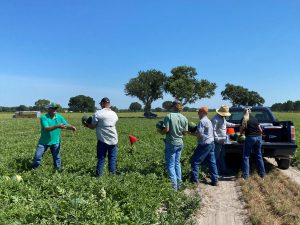LIVE OAK, Fla. — For farmers in the Suwannee Valley, using Best Management Practices (BMP) are more important than ever to efficiently irrigate their crops. At the UF/IFAS North Florida Research and Education Center – Suwannee Valley (UF/IFAS NFREC-SV), a team led by Bob Hochmuth, UF/IFAS Extension regional specialized agent for vegetable crops and assistant center director, has been researching the use of controlled release fertilizers as an advanced BMP in watermelons.
“Watermelon production has some unique aspects,” Hochmuth said. “We use plastic mulch and drip irrigation. Which means it’s not irrigated overhead, but through drip irrigation under the plastic mulch.”
A full season rate of controlled release fertilizer is applied under the plastic mulch before the crop is planted.
“We know from dozens of blue dye tests throughout the years that watermelon crops are really vulnerable to leaching fertilizer below the root zone early in the season,” said Hochmuth. “Typically, in conventional fertilizer programs, a portion of the nitrogen and potassium and all of the phosphorus and micronutrients are placed in the soil bed. Currently, our general recommendation would be to place all the phosphorus and micronutrients, because they tend not to leech as much. However, nitrogen and potassium are highly soluble, and we recommend only placing 30% upfront.”
Since the reduction of nitrogen in the Suwannee Valley is a key component in the Basin Management Action Plan (BMAP), research has been focused on BMPs for nitrogen.
“It makes sense to me that we utilize controlled release fertilizer for nitrogen, because it’s going to be less vulnerable to leaching,” said Hochmuth. “The nitrogen is released in small quantities to meet the crop needs. But, what is released is still vulnerable to leaching due to a heavy rain event or overirrigation.”

Research on controlled release fertilizer has been conducted at UF/IFAS NFREC-SV for three years. In 2020, research was moved to large on-farm demonstrations.
“On-farm demonstrations are so important to our research projects,” said Hochmuth. “Moving projects on-farm allows us to see how our research works on a farm production level. This year was our second-year on-farm and we were grateful to have four producers collaborate with us.”
One of those farms in 2021 was Watson Farms in Levy County. Greg and Dale Watson are the father-son team that managed the project on-farm.
“One thing we learned is that controlled release can save you water,” said Greg Watson. “In order to use liquid nitrogen, you have to run your water longer to reach every plant.”
Using controlled release fertilizer can also reduce the amount of nitrogen leaching early in the season.
“Controlled release fertilizer is protected from being leached due to the coating,” said Mark Warren, UF/IFAS Levy County extension agent, who worked in partnership with Hochmuth at Watson Farms. “The coating provides protection for the fertilizer from over-irrigation or leaching rainfall.”
“What is clear from our on-farm demonstrations, is that it is even more important to do a better job irrigating when using controlled release fertilizer,” Hochmuth said. “But, if used properly, controlled release fertilizer is a tool to reduce our nitrogen use in watermelons.”
The importance of irrigation can be summed up by Watson, “when you control your water, you can control your nutrients.”
 0
0
